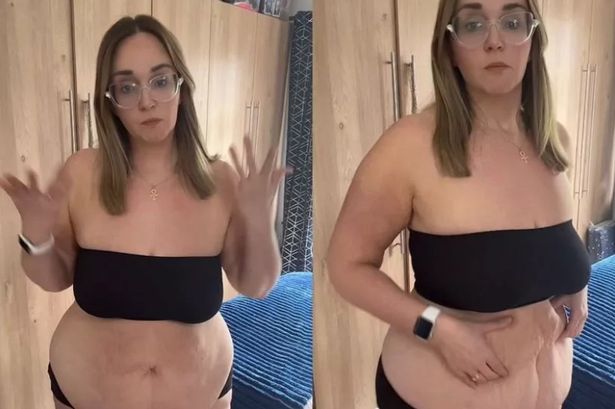Kelly Whittaker, like many women, experienced significant changes in her body composition after pregnancy and childbirth. These changes often include excess skin and fat deposits that are resistant to traditional weight-loss methods like diet and exercise. For Whittaker, this manifested as “soggy skin,” a common complaint among women who have undergone pregnancies. Despite her dedicated efforts to regain her pre-pregnancy figure through rigorous diet and exercise regimes, including cardiovascular workouts, she found herself frustrated by the persistence of loose skin, particularly in areas like the abdomen, which had stretched to accommodate the growing fetus. This experience, while disheartening, is not uncommon. Pregnancy dramatically alters the body’s physiology, including the stretching of the skin and the weakening of abdominal muscles, changes that often cannot be fully reversed by lifestyle changes alone. Whittaker’s frustration with the lack of desired results from conventional methods ultimately led her to consider surgical intervention in the form of a “mummy makeover.”
A “mummy makeover” is a combination of surgical procedures designed to address the physical changes brought about by pregnancy and breastfeeding. It typically involves a tummy tuck (abdominoplasty), breast lift (mastopexy) or augmentation (breast implants), and sometimes liposuction to remove stubborn fat deposits. The tummy tuck removes excess skin and tightens the abdominal muscles weakened during pregnancy. The breast lift or augmentation restores the shape and fullness of the breasts, which can often deflate or sag after pregnancy and breastfeeding. Liposuction, if included, helps to sculpt and contour the body by removing unwanted fat. This comprehensive approach aims to restore the pre-pregnancy physique or create a new, improved body contour. The specific procedures included in a mummy makeover are customized based on the individual’s needs and desired outcomes. For Whittaker, the combination of procedures offered a solution to address her concerns about loose skin and potentially other post-pregnancy body changes.
Whittaker’s decision to undergo a mummy makeover signifies a growing trend among women seeking to regain their body confidence after childbirth. While diet and exercise can undeniably improve overall health and fitness, they often fall short in addressing the significant skin laxity and muscle separation that can occur during pregnancy. The “mummy makeover” offers a more direct and targeted approach to these specific concerns. It’s important to note that this type of surgery is a significant undertaking, requiring careful consideration of the potential risks and benefits. It’s essential for women considering this procedure to consult with a qualified and experienced plastic surgeon to discuss their individual needs, expectations, and potential outcomes. A thorough evaluation is crucial to ensure that the patient is a suitable candidate for surgery and to develop a personalized surgical plan.
The immediacy of the results Whittaker experienced, described as “pretty much instant,” is typical of surgical procedures, especially in terms of the removal of excess skin and the reshaping of the body contours. However, it’s crucial to understand that the complete healing process takes time. While the initial results are visible soon after surgery, the body continues to heal and adjust over several weeks and even months. The final results, including the full extent of scar fading and tissue settling, may not be fully apparent for up to a year. During this period, patients need to adhere to post-operative care instructions, including wearing compression garments, managing pain and swelling, and avoiding strenuous activities. Regular follow-up appointments with the surgeon are also essential to monitor healing progress and address any potential complications.
Whittaker’s story highlights the emotional impact that post-pregnancy body changes can have on women. Many women struggle with body image issues after childbirth, feeling self-conscious about the changes in their appearance. The frustration of persistent loose skin, despite diligent efforts through diet and exercise, can significantly impact self-esteem and body confidence. For some women, like Whittaker, a mummy makeover can be a powerful tool for reclaiming their bodies and restoring their sense of self. It’s important to acknowledge that such procedures are a personal choice and should not be viewed as a necessity or a measure of one’s worth. However, for women who have exhausted other avenues and remain significantly distressed by their post-pregnancy bodies, surgical intervention can provide a much-needed sense of control and empower them to feel comfortable and confident in their own skin again.
In conclusion, Kelly Whittaker’s experience reflects the challenges many women face in regaining their pre-pregnancy bodies. While diet and exercise are vital components of a healthy lifestyle, they may not be sufficient to address the significant skin laxity and muscle separation that can occur during pregnancy. For women like Whittaker, a mummy makeover offers a more targeted solution to these specific concerns, providing a more immediate and dramatic transformation. However, it’s crucial to approach such procedures with realistic expectations, understanding the commitment involved in the recovery process and the potential risks associated with any surgical intervention. Ultimately, the decision to undergo a mummy makeover is a personal one, driven by individual needs and desires. It’s essential for women considering this option to consult with a qualified plastic surgeon, thoroughly research the procedure, and ensure they are fully informed about the benefits, risks, and long-term implications before making a decision.














